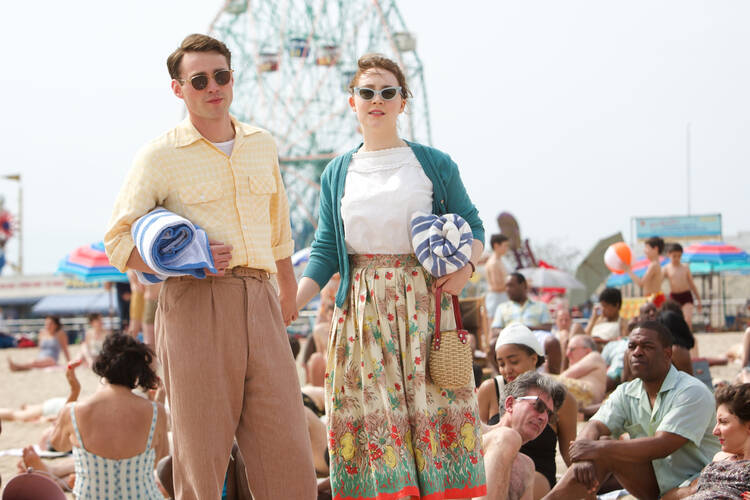“Brooklyn” is perhaps the gentlest film to be nominated for an Oscar in many years. It tells the story of Ellis Lacy (Saoirse Ronan), a young Irish woman who leaves her restricted life in her hometown of Enniscorthy to create a larger future for herself in America. A kindly Irish-American priest has found a job for her and a place to live in Brooklyn in the early 1950s. The muted colors throughout the film depict the Brooklyn she comes to know in almost sepia tones creating a sense of nostalgia about the time and place.
The film is based on the novel by the Irish writer Colm Toibin, with the screenplay written by Nick Hornby, who has been a screenwriter for such films as “About a Boy,” “High Fidelity” and “An Education,” each of them a version of a coming-of-age story about young adults. So is “Brooklyn,” but it is more than that. It vividly portrays the extreme homesickness of our heroine in a strange land. As the former president of the Irish Republic, Mary McAleese has said, “The immigrant’s heart marches to the beat of two quite different drums, one from the old homeland and the other from the new,” a perfect description of Ellis’s situation.
She settles in her job as a shop girl in an upscale department store living in a boarding house for young Irish women run by the sharp-tongued landlady, played by the venerable British actress, Julie Walters, who presides over the dinner conversation of the randy young girls displaying typical Irish sarcasm and wit. Ellis’s life takes a major turn when she meets Tony Fiorello (Emory Cohen), a young Italian plumber that she meets at a parish dance. It was common in those days for the different ethnic tribes in many cities to dislike each other, but Tony early on admits to Ellis, “I just love Irish girls.” A working man, he is as gentlemanly as any of the aristocrats in Jane Austen’s stories. They grow closer until they realize that they are in love and want to get married.
However, Ellis’s older sister, who remained in Ireland to help their widowed mother, dies, and Ellis feels it is her duty to return for a brief stay with her mother and stick around for her best friend’s wedding. She has matured considerably and is much more self-confident, even getting a job as an accountant at a local business. But, as luck would have it, a handsome upper-class fellow, Jim Farrell (Domnhall Gleeson), takes a shine to her and a romance between them develops, leaving Ellis in a dilemma. Should she return to Brooklyn and Tony or should she pursue a comfortable life with Jim?
Far be it from me to divulge her decision. The suspense surrounding her deliberation is only one feature of the story. The clash of cultures becomes clear amid the beautiful Irish landscape and the charms of working-class Brooklyn, the product of the art directors, Irene O’Brien and Robert Parle, and the gentle musical background of the Canadian composer, Michael Brook. The other young women at the boarding house, Irish immigrants themselves, introduce her to the pleasures of being young in America. Saoirse Ronan subtly grows from a shy, diffident girl in Ireland into a more sophisticated and self-assured young American woman of the 1950s. With her native intelligence, she does quite well in an accounting class at a local night school program. We can see that, whatever she decides, she will do well.
Ronan, who has been acting ever since she was a child, is well suited for the role of Ellis Lacy. She was born in the Bronx to a pair of struggling Irish immigrants who moved back to Ireland when Saoirse was three years old. She is perhaps best known for her role as the scheming younger sister of Keira Knightley’s character in the 2007 film, “Atonement,” for which she received an Oscar nomination for Best Supporting Actress at the age of 13. Now 21 years old, she continues to impress audiences and critics alike.
The story is solidly set in the early 1950s, when the prosperous post-war economy prompted Americans to dream of better jobs, houses in the suburbs and plenty of opportunities. Meanwhile, Ireland’s economy stagnated with few employment opportunities and modest standards of living. In fact, throughout the decade, about 15 percent of the Irish population—mostly the best and the brightest young people—left Ireland for better prospects. Both Enniscorthy and Brooklyn are depicted as romantic but confining in their own way, thanks to the subtle direction of a relative newcomer, John Crowley, who has received numerous awards for his work in both England and Ireland.
“Brooklyn,” likewise, has already garnered several awards internationally and has been nominated by the Motion Picture Academy for Best Film, Best Actress and Best Screenplay and has done quite well at the box-office. What a pleasure it is to see this tale of rather ordinary people with recognizable motives and problems alongside of the violence of “The Revenant” and “Mad Max: Fury Road,” the real-life scandals and exposes of “Spotlight” and “The Big Short,” the international conflict in “Bridge of Spies,” and the interstellar adventures of “The Martian.” Against such impressive films and outstanding performances, this modest story probably doesn’t stand much of a chance of winning an Oscar or two. However, as a piece of nostalgia, a romantic little gem, and a portrayal of the plight of immigrants, it is hard to beat.








